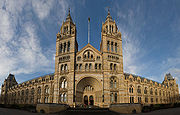
Gibbs and Canning Limited
Encyclopedia
Gibbs and Canning Limited was an English
manufacturer
of terracotta and, in particular, architectural terracotta
, based in Glascote, Tamworth
and founded in 1847.
The company manufactured a wide range of terracotta and faience: statues of lions and pelicans to adorn the Natural History Museum in London; architectural terracotta for banks and schools; and garden urns and planters. By the 1950s, when the factory finally closed, it was best known for more practical items such as drainage pipes, sinks, vases and jars.
Today, there is little evidence of the factory in Glascote, but the legacy lives on in the decoration and plumbing of many buildings in Britain’s major towns and cities.

England
England is a country that is part of the United Kingdom. It shares land borders with Scotland to the north and Wales to the west; the Irish Sea is to the north west, the Celtic Sea to the south west, with the North Sea to the east and the English Channel to the south separating it from continental...
manufacturer
Manufacturing
Manufacturing is the use of machines, tools and labor to produce goods for use or sale. The term may refer to a range of human activity, from handicraft to high tech, but is most commonly applied to industrial production, in which raw materials are transformed into finished goods on a large scale...
of terracotta and, in particular, architectural terracotta
Architectural terracotta
Terracotta, in its unglazed form, became fashionable as an architectural ceramic construction material in England in the 1860s, and in the United States in the 1870s. It was generally used to supplement brick and tiles of similar colour in late Victorian buildings.It had been used before this in...
, based in Glascote, Tamworth
Tamworth
Tamworth is a town and local government district in Staffordshire, England, located north-east of Birmingham city centre and north-west of London. The town takes its name from the River Tame, which flows through the town, as does the River Anker...
and founded in 1847.
The company manufactured a wide range of terracotta and faience: statues of lions and pelicans to adorn the Natural History Museum in London; architectural terracotta for banks and schools; and garden urns and planters. By the 1950s, when the factory finally closed, it was best known for more practical items such as drainage pipes, sinks, vases and jars.
Today, there is little evidence of the factory in Glascote, but the legacy lives on in the decoration and plumbing of many buildings in Britain’s major towns and cities.
Buildings featuring Gibbs and Canning terracotta

- Natural History MuseumNatural History MuseumThe Natural History Museum is one of three large museums on Exhibition Road, South Kensington, London, England . Its main frontage is on Cromwell Road...
, South Kensington, London. Designed by Alfred WaterhouseAlfred WaterhouseAlfred Waterhouse was a British architect, particularly associated with the Victorian Gothic Revival architecture. He is perhaps best known for his design for the Natural History Museum in London, and Manchester Town Hall, although he also built a wide variety of other buildings throughout the...
. Both the interior and exterior statues, and the block-work, are Gibbs and Canning (G&C). - Royal Albert HallRoyal Albert HallThe Royal Albert Hall is a concert hall situated on the northern edge of the South Kensington area, in the City of Westminster, London, England, best known for holding the annual summer Proms concerts since 1941....
, South Kensington, London. The buff, ornamental terracotta on the exterior. - 142 Holborn Bars, Prudential plcPrudential plcPrudential plc is a multinational financial services company headquartered in London, United Kingdom.Prudential's largest division is Prudential Corporation Asia, which has over 15 million customers across 13 Asian markets and is a top-three provider of life insurance in mainland China, Hong...
Assurance Building, Holborn, London. Designed by Alfred Waterhouse with all the red terracotta by G&C. - Methodist Central Hall, BirminghamMethodist Central Hall, BirminghamThe Methodist Central Hall, 196-224 Corporation Street, Birmingham, England, is a three storey red brick and terracotta Grade II* listed building with a distinctive tower at the northern end of Corporation Street, opposite the Victoria Law Courts...
. Ornate, red terracotta. - Imperial Buildings, Victoria Street/Whitechapel corner, Liverpool.
- Manchester Town HallManchester Town HallManchester Town Hall is a Victorian-era, Neo-gothic municipal building in Manchester, England. The building functions as the ceremonial headquarters of Manchester City Council and houses a number of local government departments....
Designed, again by Alfred Waterhouse.
External links
- Research page including details of many buildings that used Gibbs and Canning terracotta
- Chemlinski Gallery - English Terracotta
- Tamworth Castle - has a small display Gibbs and Canning wares and manufacturing techniques

